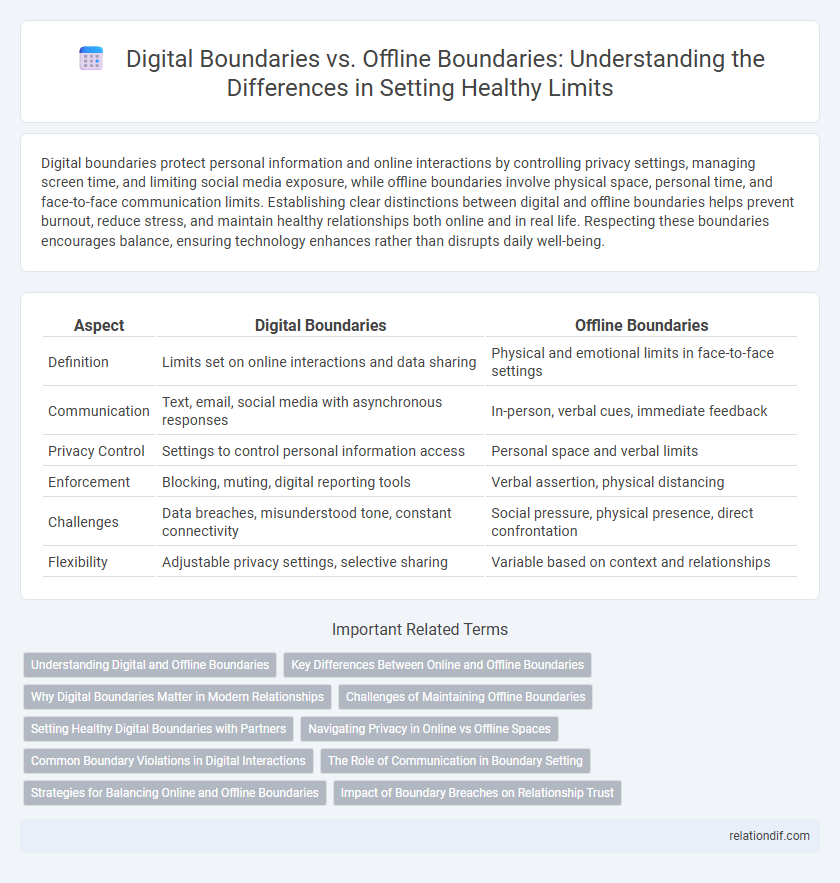Digital boundaries protect personal information and online interactions by controlling privacy settings, managing screen time, and limiting social media exposure, while offline boundaries involve physical space, personal time, and face-to-face communication limits. Establishing clear distinctions between digital and offline boundaries helps prevent burnout, reduce stress, and maintain healthy relationships both online and in real life. Respecting these boundaries encourages balance, ensuring technology enhances rather than disrupts daily well-being.
Table of Comparison
| Aspect | Digital Boundaries | Offline Boundaries |
|---|---|---|
| Definition | Limits set on online interactions and data sharing | Physical and emotional limits in face-to-face settings |
| Communication | Text, email, social media with asynchronous responses | In-person, verbal cues, immediate feedback |
| Privacy Control | Settings to control personal information access | Personal space and verbal limits |
| Enforcement | Blocking, muting, digital reporting tools | Verbal assertion, physical distancing |
| Challenges | Data breaches, misunderstood tone, constant connectivity | Social pressure, physical presence, direct confrontation |
| Flexibility | Adjustable privacy settings, selective sharing | Variable based on context and relationships |
Understanding Digital and Offline Boundaries
Digital boundaries define how personal information is shared online, controlling access to social media profiles, messages, and digital content to protect privacy and mental well-being. Offline boundaries involve physical and emotional limits set in face-to-face interactions, maintaining respect and personal space in real-world environments. Understanding the distinction between digital and offline boundaries is crucial for navigating relationships effectively and ensuring balance between virtual communication and real-life interactions.
Key Differences Between Online and Offline Boundaries
Digital boundaries emphasize protecting personal data, managing online privacy settings, and controlling digital interactions, whereas offline boundaries focus on physical space, face-to-face communication, and direct emotional cues. Online boundaries require vigilance against cyber threats, social media oversharing, and digital interruptions, while offline boundaries rely on non-verbal signals, physical distance, and situational awareness. Both forms of boundaries are essential for maintaining healthy relationships, but they differ fundamentally in medium, perception, and enforcement methods.
Why Digital Boundaries Matter in Modern Relationships
Digital boundaries protect individuals' privacy and emotional well-being by regulating access to personal information and interactions on social media, messaging apps, and online platforms. Unlike offline boundaries, digital boundaries require continuous negotiation due to the constant connectivity and potential for misunderstandings caused by asynchronous communication. Establishing clear digital boundaries strengthens trust and respect in modern relationships by preventing overreach, reducing conflicts, and promoting healthy online behavior.
Challenges of Maintaining Offline Boundaries
Maintaining offline boundaries presents challenges such as constant physical proximity, making it harder to create personal space and limit interruptions. Unlike digital boundaries, offline boundaries require clear non-verbal communication and consistent enforcement in real-time social settings. The lack of digital tools to control interaction timing and intensity adds complexity to managing offline personal limits effectively.
Setting Healthy Digital Boundaries with Partners
Setting healthy digital boundaries with partners involves clearly defining acceptable online behaviors, such as privacy expectations around social media and messaging apps, to prevent misunderstandings and maintain trust. Establishing limits on screen time, sharing passwords, and respecting each other's digital privacy promotes emotional security and mutual respect in the relationship. Prioritizing open communication about digital habits supports balance between online interactions and offline connection, reinforcing overall relationship well-being.
Navigating Privacy in Online vs Offline Spaces
Digital boundaries require constant adjustment due to the pervasive nature of online interactions, where personal data is frequently shared and stored across multiple platforms, increasing privacy risks. Offline boundaries rely more on physical space and face-to-face interactions, allowing for clearer control over personal information and social engagement. Navigating privacy effectively involves recognizing the differences in visibility and permanence between online and offline environments to maintain control over one's personal and social boundaries.
Common Boundary Violations in Digital Interactions
Common boundary violations in digital interactions include oversharing personal information, unsolicited messaging, and persistent tagging or commenting on social media platforms. Unlike offline boundaries, digital boundaries often blur due to the asynchronous nature of communication and the permanence of online content. Recognizing these violations helps maintain respectful digital etiquette and protects privacy in virtual environments.
The Role of Communication in Boundary Setting
Effective communication plays a pivotal role in establishing both digital and offline boundaries, ensuring clarity and mutual respect. In digital spaces, clear articulation of availability, privacy preferences, and response expectations helps prevent misunderstandings and protects personal space. Offline, open dialogue around limits fosters trust and reinforces the importance of maintaining individual well-being.
Strategies for Balancing Online and Offline Boundaries
Establishing clear digital boundaries involves setting specific time limits for online activity and using privacy settings to control personal information exposure. Offline boundaries require communicating availability and expectations in face-to-face interactions to maintain personal space and mental well-being. Integrating these strategies helps create a balanced lifestyle that respects both virtual connectivity and real-world relationships.
Impact of Boundary Breaches on Relationship Trust
Boundary breaches in digital spaces often lead to more immediate and visible trust issues compared to offline boundaries due to the permanence and wide reach of online interactions. Violations such as unauthorized sharing of personal information or digital surveillance intensify feelings of vulnerability and can irreparably damage relationship trust. Offline boundary breaches, while significant, may allow for more direct communication and resolution, but both domains critically affect the foundation of trust in relationships.
digital boundaries vs offline boundaries Infographic

 relationdif.com
relationdif.com